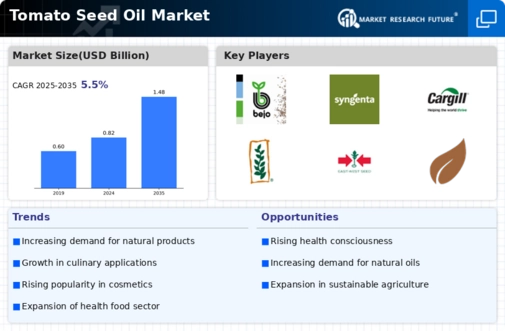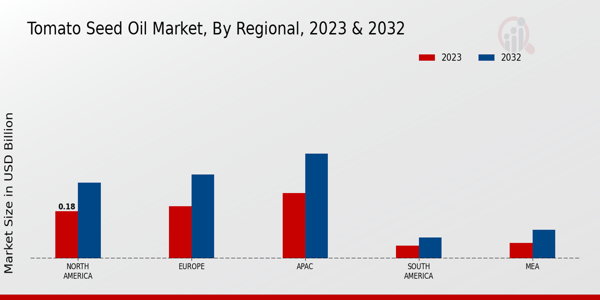Market Growth Projections
The Global Tomato Seed Oil Market Industry is poised for substantial growth, with projections indicating a market value of 0.82 USD Billion in 2024 and an anticipated increase to 1.48 USD Billion by 2035. This growth trajectory suggests a compound annual growth rate of 5.5% from 2025 to 2035. Such figures highlight the increasing consumer interest in tomato seed oil, driven by health trends, culinary innovations, and sustainability concerns. The market's expansion reflects a broader shift towards natural and health-oriented products, positioning tomato seed oil as a key player in the global oils market.
Rising Health Consciousness
The increasing awareness regarding health and wellness among consumers appears to drive the Global Tomato Seed Oil Market Industry. As individuals seek healthier alternatives to traditional cooking oils, tomato seed oil, rich in antioxidants and essential fatty acids, is gaining traction. This trend is particularly evident in regions where dietary habits are shifting towards plant-based options. The market is projected to reach 0.82 USD Billion in 2024, reflecting a growing preference for nutritious oils. As consumers become more informed about the benefits of tomato seed oil, its demand is likely to rise, contributing to the overall growth of the industry.
Expanding Culinary Applications
The versatility of tomato seed oil in culinary applications seems to enhance its appeal within the Global Tomato Seed Oil Market Industry. Chefs and home cooks alike are discovering its unique flavor profile, which complements a variety of dishes, from salad dressings to marinades. This expanding use in gastronomy is supported by an increasing number of food products incorporating tomato seed oil as a key ingredient. As the culinary landscape evolves, the demand for innovative cooking oils is likely to grow, positioning tomato seed oil as a preferred choice. This trend may significantly contribute to the industry's projected growth, with an anticipated market value of 1.48 USD Billion by 2035.
Innovative Marketing Strategies
The implementation of innovative marketing strategies by producers appears to play a crucial role in the growth of the Global Tomato Seed Oil Market Industry. Companies are increasingly utilizing digital platforms and social media to educate consumers about the benefits of tomato seed oil, thereby enhancing brand visibility and consumer engagement. Targeted campaigns that highlight the oil's health benefits and culinary versatility may attract a broader audience. As awareness increases, the market is likely to experience a surge in demand, contributing to its projected growth trajectory. This proactive approach to marketing could be instrumental in achieving the anticipated market value of 1.48 USD Billion by 2035.
Growing Demand for Natural Ingredients
The shift towards natural and organic ingredients in food products appears to be a driving force in the Global Tomato Seed Oil Market Industry. Consumers are increasingly scrutinizing ingredient labels, favoring products that are free from artificial additives and preservatives. Tomato seed oil, being a natural extract, aligns well with this consumer preference. The rise of clean-label products is likely to bolster the demand for tomato seed oil, as manufacturers seek to meet the expectations of health-conscious consumers. This trend may contribute to a compound annual growth rate of 5.5% from 2025 to 2035, further solidifying the oil's position in the market.
Sustainability and Environmental Concerns
The growing emphasis on sustainability and environmentally friendly practices seems to influence the Global Tomato Seed Oil Market Industry positively. As consumers become more aware of the environmental impact of their choices, there is a noticeable shift towards products that are sustainably sourced and produced. Tomato seed oil, often derived from by-products of the tomato processing industry, presents an opportunity to reduce waste and promote sustainable practices. This alignment with eco-conscious consumer values may enhance the market's appeal, potentially leading to increased sales and a stronger market presence as sustainability becomes a priority for both consumers and manufacturers.













